

Jon Clements, Author (unless otherwise noted) and Editor
Current degree day accumulations
2015 New England Tree Fruit Management Guide Available
| UMass Cold Spring Orchard, Belchertown, MA |
7-April |
| Base 43 (SkyBit) | 28 |
| Base 50 (NEWA) | 9 |
Note that apple green tip should occur app. 101 DD (Base 43.) Based on the SkyBit forecast, which goes out to 4/17, 81 DD's are predicted to accumulate by then. We'll see.
Current bud stages. April 8, 2015, UMass Cold Spring Orchard, Belchertown, MA
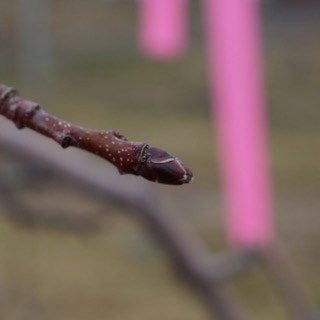 |
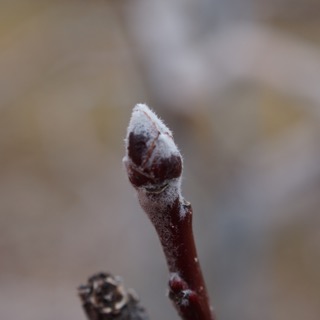 |
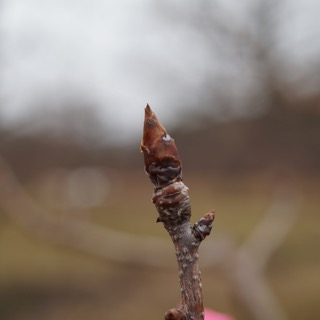 |
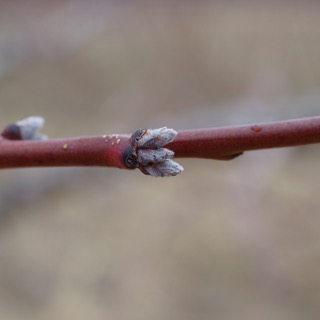 |
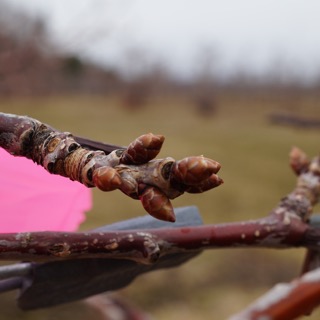 |
Honeycrisp apple dormant |
McIntosh apple swollen dormant |
Gold Russet Bosc Pear dormant |
PF-14 Jersey peach dormant |
Rainier sweet cherry dormant |
| Coming events | Degree days (Base 43) |
| Green fruitworm 1st catch | 50-152 |
| Pear psylla adults active | 31-99 |
| Pear psylla 1st oviposition | 40-126 |
21-April, 2015 (Tuesday) Fruit Twilight Meeting at UMass Cold Spring Orchard, 393 Sabin St., Belchertown, MA. 5:30 PM. 1 pesticide credit will be offered. Light dinner will be served. $20 meeting fee. Contact: Jon Clements, 413-478-7219. Pre-registration is not necessary.
22-April, 2015 (Wednesday) Fruit Twilight Meeting at Carlson Orchards, 115 Oak Hill Rd., Harvard, MA. 5:30 PM. 1 pesticide credit will be offered. Light dinner will be served. $20 meeting fee. Contact: Jon Clements, 413-478-7219. Pre-registration is not necessary.
23-April, 2015 (Thursday) Fruit Twilight Meeting in cooperation with University of Rhode Island at Goodwin Brothers Farms Stand, 458 Greenville Rd., North Smithfield, RI. 2 pesticide credits. Light dinner will be served. $20 meeting fee (except RIFGA members). Contact: Jon Clements, 413-478-7219, or Heather Faubert, 401-874-2967. Pre-registration is not necessary.
For more information and updates, see Upcoming Events
• This may be your last Healthy Fruit (HF) unless you go to the UMass Extension Bookstore (http://umassextensionbookstore.com) and purchase a new 2015 subscription to HF ($50, e-mail delivery only) in the next week or two. Alternately, you can send me (Jon Clements, 393 Sabin St., Belchertown, MA 01007) a check for $50 made out to 'University of Massachusetts.' Make sure you note it is for Healthy Fruit subscription, and includes your e-mail address. You can also use this mail-in form to order Healthy Fruit and other UMass fruit publications.
• Sometimes I run into some confusion regarding our UMass fruit program publications and membership in Massachusetts Fruit Growers' Association (MFGA). MFGA membership is $200 ($25 for non-grower members) and includes a complimentary subscription to American Fruit Grower. It does not include any UMass fruit program publications. You can join or renew your MFGA membership using a credit card here. (You can also make a voluntary donation to the UMass Cold Spring Orchard Research & Education Center, UMass Apple IPM Program, and/or MFGA's Horticultural Research Fund.) You can also join or renew MFGA using a mail-in form here. Note that using the mail-in form you can also order UMass fruit publications, but I don't recommend ordering UMass fruit publications with your MFGA membership using that form. If you want to order UMass fruit publications, I recommend you use this mail-in form. (But you still can't use a credit card to order those -- boo hoo!) I hope that clears things up a bit. I encourage you to both join MFGA and order the UMass fruit publications that are of interest to you. More information on our UMass fruit publications is available here. If you have any questions, please get in touch with me.
• Otherwise, things are dormant and a little cool and wet (for now). Just like last year. Green tip on apple last year was April 14. We may be at green tip after that (late) date this year. Still waiting to see what the stone fruit bloom is going to be like after this winter.
• A collaboration of tree fruit specialists in all six New England states, and with Cornell University, the 2015 New England Tree Fruit Management Guide (NETFMG) is a must-have for all commercial orchardists. The 2015 NETFMG is 283 pages and includes chapters on: Integrated Crop & Pest Management; Organic Tree Fruit Production in New England; Pesticide and Sprayer Information; Characteristics of Crop Protectants Used on Tree Fruits; Disease, Insect, Weed, Wildlife, and Nutrient Management; and specific spray management recommendations for Apples, Pears, Cherries, Peaches and Nectarines, Apricots, and Plums and Prunes. The 2015 NETFMG is available for purchase for $25 on the UMass Extension Bookstore, http://umassextensionbookstore.com/. (Or you can also use this mail-in form to order Healthy Fruit and other UMass fruit publications.) The 2015 NETFMG will also be available for sale at Fruit Twilight Meetings.
• This just received from Heather Faubert, University of Rhode Island. For those of you who have to worry about winter moth.
"Winter moth eggs are still orange and not ready to hatch. I've checked with cooperating egg watchers, and their eggs are still orange too. Eggs turn blue a couple of days before they hatch.
"Last night I compared growing degree days (GDD) recorded on the Weather Channel website with winter moth hatch dates from 2008-2014. Now this isn't very scientific - the weather data may not be accurate; I don't know exactly what temperature is needed for winter moth eggs to advance; and the hatch date may be a little off, but I think the information could be useful. I found winter moth eggs hatching between 105-152 GDD base 40 when I started calculating GDD on March 1st. Three of those years, eggs hatched within 2 GDD of 114 GDD base 40.
You can check growing degree days at your location too. See this website:
http://www.yourweekendview.com/outlook/agriculture/growing-degree-days/
Enter your zipcode
Select base temperature 40
Select start date - I suggest using March 1st
Select end date - use yesterday's date
Click on Calculate
I checked a few locations of GDD base 40 for March 1 - April 7:
Bristol 42
Cumberland 32.5
Greenville 32.5
Kingston 39
Middletown 28
Wakefield 33
Warwick 42
Last year for March 1 - April 7 we were 15-36 GDD, base 40, higher than we are this year. GDD for April 7, 2014 ranged from 53-80. Last year was a late spring and this year is later - as if you didn't know!
When eggs start to turn blue, apply an insecticide to protect apple, pear, and blueberry flower buds. I know some landscape trees will sprayed then too. Good insecticides to use for fruit include Imidan, Sevin, Delegate, and Entrust (organic formulation of spinosad). If you have a small number of plants to treat you can purchase a small quantity of spinosad called Captain Jack's Deadbug Brew. It has the same active ingredient as Entrust, but is formulated for home use. It is not certified organic. The landscape formulation of spinosad is Conserve.
Once eggs hatch and the caterpillars climb inside buds, the caterpillars will be protected from insecticide sprays. It doesn't do any good to spray insecticide after caterpillars are inside the buds and the buds aren't opened. Once buds open and the larger caterpillars start moving around, they are again susceptible to insecticides. After buds open, a Bt product (Bacillus thuringiensis), such as Dipel, is also effective at controlling winter moth caterpillars. Bt doesn't work at egg hatch because the caterpillars don't feed before they enter buds. Bt needs to be ingested to kill caterpillar
I will alert you when any monitored eggs turn blue! Eggs are being monitored in Westerly, Kingston, Warwick, Cumberland, and Acushnet, MA.
• A green tip copper spray to apple and pear is one part of a fire blight management program. Given the fact there was so much fire blight last year, a green tip copper spray (of your favorite product) at a higher rate his strongly advised. Apply to all your apple and pear blocks at green tip.
• This on the start of "Apple Scab Season" from Arthur Tuttle, Liz Garofalo, and Dan Cooley who are doing a rather extensive apple scab spore monitoring protocol:
"We are starting early to track apple scab spore maturation. On 4/6 we ran two different spore trapping devices (designed by Bill MacHardy at UNH) using leaves that were collected from unsprayed trees last Fall and were placed outdoors under hardware cloth all winter. We thought that the rains that occurred last Friday and over the weekend might possibly promote scab maturation, and with silver tip in 'MacIntosh' at Belchertown looming on the horizon, we wanted to test our equipment and document that no spores were flying. Both traps have fans that blow air across the wet scabby leaves and if spores are released, some of them land on a strategically placed microscope slide. RESULTS: no scab ascospores were seen on the slides when they were examined in the lab.
"At the same time we ran 2 lab tests to confirm ascopore maturation. One test is called a squash mount: a sample of the same leaf collection was brought into the lab and after soaking in water, 10 of the small dark structures containing the spores were teased off the leaf surface and placed on a microscope slide. After placing a dot of water and a cover slip on the slide, the structures were crushed with a small dowel. The crushed structures were examined at 200 X and 400 X magnification. RESULTS: of the 10 structures (pseudothecia), 3 had ascal sacs containing mature spores. One had 2 sacs and the other two had one each. This indicates that there is some development, and that when the trees get to green tip, we should see more development, and the beginning of spore release.
"The second test is more like the spore trapping tests. Sections of leaves from the same collection are cut and soaked in water and stuck to the lid of petri plates. 2 microscope slides are placed in the bottoms of the petri plates, the plates are closed and set in filtered natural light for 1.5-2 hours. The slides are then examined for released ascopores. RESULTS: there were no released ascospores.
"Will will attempt to do the 2 lab tests each week, early in the week, until primary scab season is over. The spore-trapping test will be run at intervals that will depend on the rainfall in Belchertown where the scabby leaf collection resides under squares of hardware cloth near the weather station."
I often get asked how to prune older apple trees planted on semi-dwarf rootstock, for example EMLA 7. It's easy, click here.
All kidding aside, pruning is still an ongoing activity this spring given the difficult working conditions encountered over the winter. As a reminder, here are our 7 rules for pruning modern, higher-density, central-leader apple (and pear) trees:
See my blog post "My Baker's Dozen Apple and Pear Pruning Tips" for more detail and information.
Posted (http://msue.anr.msu.edu/topic/info/fruit) on April 7, 2015 by Amy Irish-Brown, and Phil Schwallier, Michigan State University Extension
Michigan State University Extension educators and growers around the state reported higher than typical San Jose scale numbers on apple fruit in bins in 2013 and somewhat in 2014. Dormant oil is an effective method to control San Jose scale and other tree fruit pests and should be considered for use in 2015 if the weather and growth stages are right.
The term “dormant” in dormant oil can be a little misleading as the more commonly used timing is delayed dormant, or as close to green tip as possible and up until the pink stage (view apple growth stages). Keep in mind oil and green tissue are not very compatible. Phytotoxic damage to buds, blossoms and fruitlets is possible, thus care must be taken to avoid weather extremes. Do not use oil sprays 48 hours before and after a frost event. Avoid using oils in very hot (over 85 degrees Fahrenheit) and humid conditions. Do not apply sulfur or Captan within several days of oil applications or phytotoxicity will occur.
Good coverage is important for all spray applications, especially when using oil to target San Jose scale where the treatment target is on and under bark scales where the overwintering scales are. A common way to use dormant oil is 2 gallons per 100 at 100 gallons water per acre at green tip with copper. Some growers will break up their oil applications into two sprays: once at green tip with copper and another at 1 gallon per 100 at tight cluster with Lorsban.
Rates need to be reduced as the oil is applied closer to pink. Spur and bud damage is a high risk at pink and should be down to no more than 1 gallon oil per 100. Late applications will offer the best help to control scale and mites and adding Lorsban or another insecticide will help control rosy aphids.
Different crop protection retailers have different products and they all work similarly. Be sure to work closely with your spray salesperson for the best recommendation and use of their products. Follow all label guidelines. Dormant oil needs to be applied with care and attention to the weather conditions before and after the application.
Follow me (jmcextman) on FB: https://www.facebook.com/jmcextman

UMass Fruit Advisor: http://umassfruit.com
Scaffolds Fruit Journal: http://www.nysaes.cornell.edu/ent/scafolds/
Network for Environment and Weather Applications (NEWA): http://newa.cornell.edu
Follow me on Twitter (http://twitter.com/jmcextman) and Facebook (http://www.facebook.com/jmcextman)
UMass Vegetable & Fruit IPM Network (on Facebook, http://www.facebook.com/umassipmteam)
The next Healthy Fruit will be published on Tuesday, April 14 or thereabouts, 2015. As always feel free to get in touch with any member of the UMass Fruit Team (http://extension.umass.edu/fruitadvisor/team-members) if you have questions or comments.